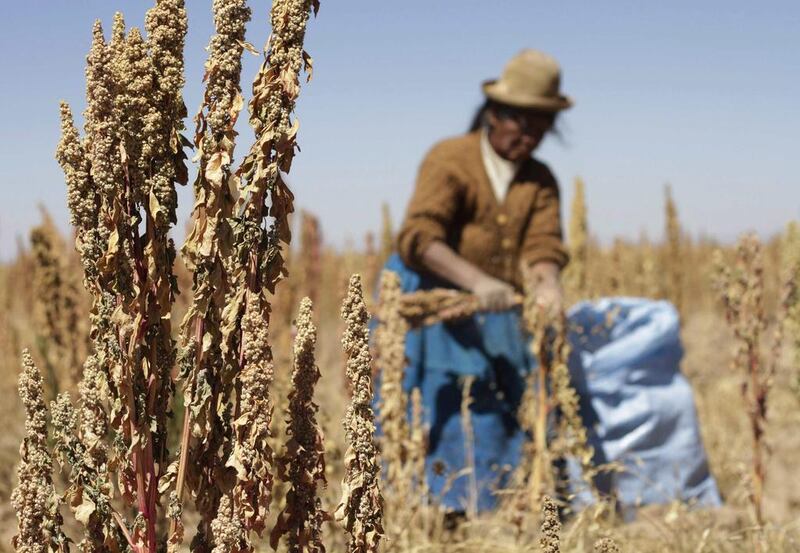You could easily have missed it, but this is the year of quinoa.
The rise of the grain has been long in coming. Its homelands in Peru and Bolivia still account for about 90 per cent of global production. There, it is put to all sorts of uses – eaten as a breakfast cereal and as a leafy vegetable. Its flour is used in bread, biscuits and pasta, and the grain for soups, purees and cakes. It is even used as a forage crop for goats.
Elsewhere, though, it remains more obscure. But its usefulness is slowly becoming more widely known.
Quinoa is exceptionally nutritious. Not only does it contain all eight amino acids needed for human health – often referred to as the "essential" amino acids – it offers useful minerals such as iron, magnesium and phosphorus.
These properties led the United Nations’ Food and Agriculture Organisation (FAO) to designate this year as “the International Year of Quinoa” – and that international focus might just extend to the UAE.
Quinoa has an extremely useful trick up its sleeve – it grows very well in highly saline conditions exactly like those found in the UAE.
To use the scientific term, it is a halophyte, thriving where most other crops would be unable to grow, which is handy in a country where the soil is extremely salty and likely to become more so.
A paper by Verana Isabelle Adolf, a scientist at the University of Copenhagen, published in Environmental and Experimental Biology in August, noted that “the most tolerant varieties of quinoa are able to cope with salinity levels as high as those present in seawater”.
Countries where the FAO has said quinoa has potential include Brazil, France, Sweden, Kenya, India and Australia.
Now a study by scientists at the International Centre for Biosaline Agriculture in Dubai has found that certain types of quinoa offer very impressive yields in the UAE – so good, in fact, that they come close to matching those seen in the Andes.
“It has very high potential,” said Dr Nanduri Rao, the co-author of the paper, published in the American-Eurasian Journal of Agricultural and Environmental Science.
Quinoa shows what Dr Rao’s paper describes as “very high” genetic variability, and its various types tolerate temperatures ranging from several degrees below freezing to 38°C, meaning that the UAE winter holds no fears for the plant.
The work on quinoa by Dr Rao and his colleague, Mohammed Shahid, dates back to the UAE winter of 2007-08, when the researchers carried out trials in Dubai.
These were repeated a year later, and then the following winter, in 2009-10, the group further tested the five varieties that had performed best in previous years, again in Dubai.
Since then, trials have been carried out in Abu Dhabi’s Western Region. The results of this work, done in conjunction with Abu Dhabi Farmers’ Service Centre, are described by Dr Rao as “encouraging”.
This winter, in a further expansion of the research programme, trials will be held in farms in the Northern Emirates in collaboration with the Ministry of Environment and Water.
With much of the data so far from experimental plots, the researchers are keen to obtain results from farm-scale trials.
“For us, the tests will be directly in the farmers’ fields, especially in farms affected by salinity, to see how it performs under these conditions. Salinity varies from farm to farm,” said Dr Rao.
“That will give us a source of information on its real performance in the field outside the experimental situation.”
Researchers at other institutes have requested seed samples from Dr Rao and his colleagues so they can conduct their own tests.
Still, it will be several years before researchers are ready to recommend the growing of quinoa here on a commercial basis.
“Identifying a new crop is time-consuming. It takes eight to 10 years before you can say, ‘This can be transferred to the farmers’,” said Dr Rao.
But on the basis of trials so far in the UAE, it seems likely that recommendation will indeed eventually be made.
newsdesk@thenational.ae






